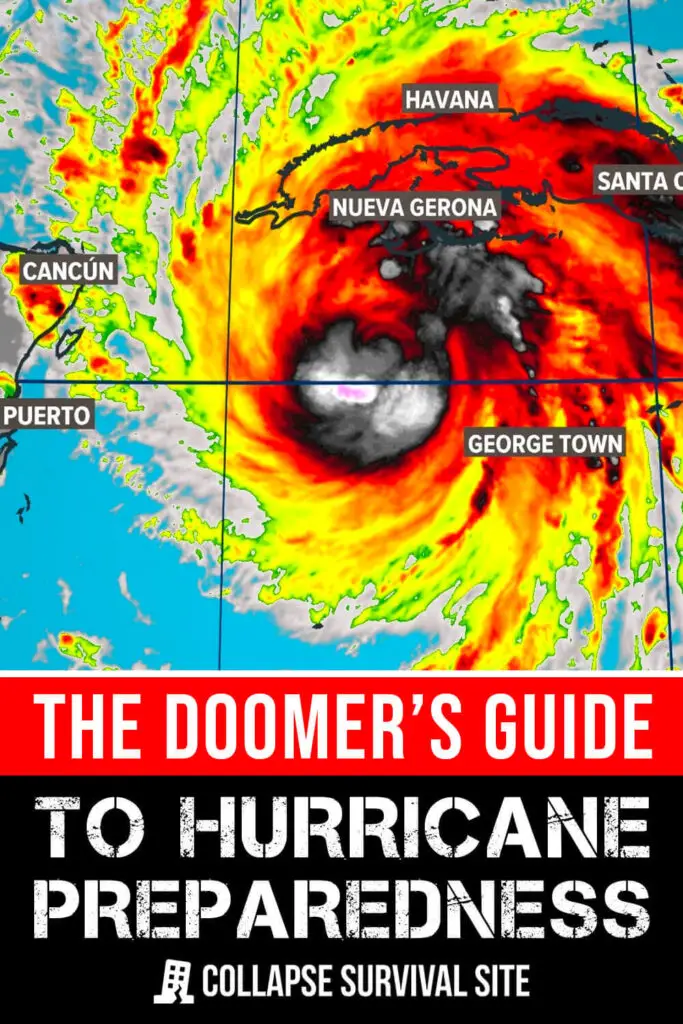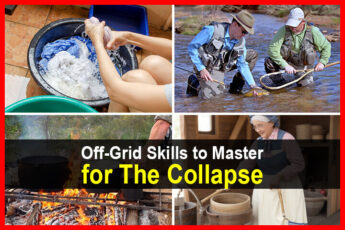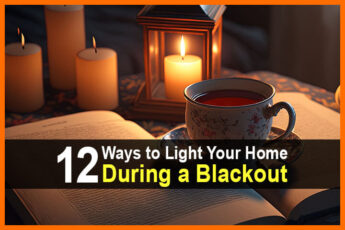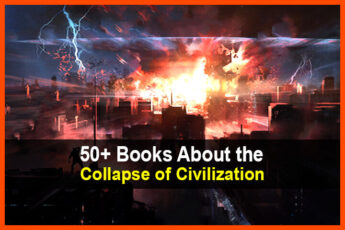Estimated reading time: 17 minutes
Climate change is here, and it’s creating the perfect conditions for category 6 hurricanes. Technically, there is no category 6, but if the scale continued upward, moving to the next category every 20-25 mph of sustained wind speeds, then category 6 would begin at about 180 mph or higher.
Several hurricanes have reached those speeds. Hurricane Dorian, for example, which killed 74 people and did $3.4 billion in damages. And there are going to be many more hurricanes like this. Some will be even worse. How do I know this? Because of record-high ocean temperatures.
In 2023, the Atlantic Ocean became shockingly warm. Starting in March, North Atlantic sea surface temperatures shot past previous record highs and kept going up. By June, they were 1.36°C above average, shocking scientists and making people wonder if we’ve crossed a climate tipping point we didn’t know about.
Want to save this post for later? Click here to Pin It On Pinterest!
But it’s not just the North Atlantic. The waters around Florida are higher than ever before, peaking at 101.1°C, which is likely the hottest ocean temperature ever recorded. Many locals say it’s like swimming in a hot tub. If you live anywhere near the Gulf Coast, this is a very bad sign.
Overall, the oceans of the world are hotter than ever, reaching 20.96°C in early August, edging out the previous high of 20.95°C set back in 2016. Part of the reason for these high ocean temperatures is the return of El Niño, which usually means fewer hurricanes.
But 2023 is different. While it’s still likely that fewer hurricanes will form, those that do will be more powerful due to the unusually high ocean temperatures. And when El Niño ends and La Niña returns…watch out.
Over the next few decades, hurricanes will hit the Southern and Eastern Coasts of the United States more often, doing more damage every year. Governments won’t have the funds to rebuild everything, and local economies will crumble. Many people will abandon the coasts, and those who remain will be in ever-greater danger.
If you live anywhere a hurricane could strike, you need to start preparing right now. Most people wait until there’s a hurricane warning before they stock up on supplies, but as someone who lives on the Gulf Coast, I can assure you that this is a bad idea.
As soon as the local weatherman mentions a possible hurricane or even a tropical storm, people rush to the stores and buy all the bottled water, toilet paper, and canned goods they can get. You don’t want to find yourself driving from store to store, hoping to find some supplies that everyone else happened to overlook.
To help you get prepared for the next major hurricane, we’re going to cover the following topics:
- Hurricane dangers
- Preparing your home
- Evacuation
- Sheltering in place
- Emergency supplies
- What to do after a hurricane
This guide might not cover everything you need for your particular situation, but it will give you a foundation on which to build. Take these ideas and modify them as necessary to create a hurricane preparedness plan that suits you and your family.
Hurricane Dangers
Hurricanes bring all sorts of dangers, from high wind speeds to widespread flooding. Once you understand the dangers, you’ll be in a better position to safely handle or even avoid them. Here are some of the most common dangerous associated with hurricanes.
Storm Surge
Storm surge occurs when vast amounts of water are pushed inland due to the powerful nature of a hurricane. The surge and accompanying rainfall will collect inland and create flood zones. These flooded zones will not recede until the hurricane has passed.
Storm surge is what caused so much damage during Hurricane Katrina. Even though the coast of Mississippi received higher winds, the storm surge in New Orleans brought the entire city to a standstill and left thousands dead.
High Winds
According to the National Hurricane Center and Central Hurricane Center, hurricane winds can range from 74-157 mph or higher. Getting wind speeds over 100 mph is like having a tornado come through, only affecting a much larger area. Hurricane winds are more than capable of ripping off rooftops, blowing structures over, knocking down trees and powerlines, and moving or even flipping vehicles over.
Utility Dangers
Due to the effects of high winds and storm surges, powerlines are often knocked to the ground, and gas and water lines can be ruptured. A power outage is easy enough to handle (unless it’s extremely hot outside), but power lines that are lying on the ground but still live can be deadly.
Ruptured gas lines could potentially cause asphyxiation or even an explosion. And if water lines are broken, you’ll need to boil or purify your water in some other way to make sure it’s safe to drink.
Power Outages
You may be able to survive a short-term power outage during a hurricane, but keep in mind that outages could last days or even weeks. Some of the critical aspects of a home that require power include refrigeration, HVAC systems, communications, and any necessary medical devices.
Access to clean water will also be affected due to power loss in an area because pump stations and water treatment plants may not be operating.
Flood Waters
Other than the obvious risk of drowning, flood waters have many hazards to be aware of. They can carry dangerous debris above the water and conceal hazards below the surface. Flood waters can wash out roads, collapse bridges, and carry away vehicles. It only takes about a foot of water to start carrying an average vehicle away.
Some of the other unseen dangers within flood waters are active power lines, as well as hazardous materials such as fuel, oils, chemicals, and sewage, not to mention any dangerous wildlife.
Preparing Your Home
In this section, we’ll talk about various things you can do to help protect your home from a hurricane.
Get Good Insurance
One of the first things you should do is to get insurance for your home and the items within it. Most homeowners already have homeowner’s insurance, but they might not have flood insurance. Remember, if the insurance companies decide your home was destroyed by a flood and not a hurricane (even though the hurricane caused the flood), they would refuse to pay unless you have a separate flood insurance policy.
If you don’t own your home, at least get renter’s insurance. As much of a pain as it is to replace items, most of them are replaceable. Being insured will help alleviate the emotional and financial stress of how to replace damaged property.
Window Protection
Windows are a weak point in any home, and they will certainly be susceptible to the high winds and flying debris generated by a hurricane.
The cheapest way to cover up windows is with plywood. Purchase as many sheets as necessary and custom-fit them to each window. Be sure to have plenty of screws, nails, a hammer, or a screwdriver.
A second option is to install hurricane shutters on the outside of your home. These durable shutters can be left on year-round and shut when needed.
Utility Shut Offs
It’s important to know where your home’s gas, water, and electrical shutoffs are located and how to operate them. If you decide to evacuate, you can turn these before you. If you don’t have one already, be sure to get a gas shutoff wrench.
Stage Furniture
Furniture, or anything that sits on the floor, should be raised and covered to help protect them from flood waters. Raising items can be done by using something as simple as cinder blocks, which will provide roughly a foot of clearance. Large tarps or sheets of plastic can then be used to cover the top of the items.
Water Proofing
Any important, valuable, or irreplaceable items such as birth certificates, deeds, medical information, family photos, etc., should be stored in hard, waterproof containers. This is also true of any emergency supplies. An affordable way to do this is to purchase plastic totes and duct tape their lids shut.
Walk Around
Walk around the exterior of your home and look for things that need to be put away or secured. Store or secure items like toys, tools, chairs, lawn decorations, bicycles, etc. Any outdoor structure, like a shed, should be anchored to the best of your ability. Think about trimming any large trees that could pose a risk to your home or nearby power lines.
Evacuation and Sheltering in Place
Some people choose to evacuate before a storm makes landfall, some choose to wait until an evacuation order has been issued, and some will choose to ride out the storm by sheltering in place. In the following sections, we will briefly cover what to do if you choose to evacuate and if you choose to shelter in place.
Evacuate
Leaving before a storm makes landfall is the safest option and when possible, preparations should be made days beforehand. When you decide to leave is a personal choice, but the sooner you do it, the safer and easier it will be.
It is generally not advised to evacuate once a hurricane has hit because it is much more dangerous. Below is an evacuation checklist.
- Make sure you have reliable transportation.
- Fill up your vehicle’s fuel tank and have as much spare fuel as possible.
- Have multiple evacuation routes planned out ahead of time.
- Have an emergency vehicle kit as well as other necessary emergency supplies.
- Have some emergency supplies in a bug out bag in case you have to leave your vehicle behind
- Along with GPS devices, have physical maps in your vehicle.
- Inform friends and family of your intended evacuation route, the destination, and approximate timetables.
Sheltering In Place
Should you decide not to evacuate, here is a checklist of items to go over when sheltering in place.
- Make sure your home is prepared as outlined in the previous section.
- Ensure you have adequate emergency supplies as outlined in the next section.
- Find the sturdiest room in your home and designate that as your safe room. Make sure your emergency supplies are in there before the storm hits.
- Inform friends and family that you will be sheltering in place and check in with them as often as possible.
Emergency Supplies to Have
The list of emergency supplies below is meant to highlight some of the most important items to have and may not include everything that could go into a hurricane emergency kit. Modify and add to the list as needed until you feel you are properly prepared.
Light Sources
It's highly likely that the power will go out during a hurricane, and being in the dark is not safe. Having a few different types of light sources will give you more options and safety.
Every emergency kit should have candles, but due to their safety risks, they should only be used as a last resort and only if you know there isn’t a gas leak.
Pocket flashlights are compact and easy to keep on your person, and headlamps give you hands-free operation. Lanterns are an easy way to keep an area lit up, and LED bulbs with USB cords can be powered by different devices.
Communications
A smartphone is going to be a person's go-to communication device. But during or after a bad storm, these phones may not work. Consider getting a power bank and a solar panel to keep it charged.
If cell service is down, texts might still go through. If they don’t, it would be great to have a satellite phone or a HAM radio set and a license to use it. At a minimum, you should have an emergency radio. While this won’t allow you to communicate with someone, it will provide information on the status of the hurricane.
Batteries, Chargers, Power Generation
Make sure you have plenty of extra batteries for devices that require them and spare charging cables for rechargeable devices.
You also need to give some thought to your power needs and what level of power generation you want to invest in. Something small and portable like a SunJack can power small devices, whereas a power bank like a Jackery or a fuel generator can power items as large as appliances.
Hygiene and Sanitation
A lack of power and access to clean water will pose a risk to hygiene and sanitation. Here are some items to have on hand that will help you to stay clean and safe.
- Hand sanitizer will help you to keep your hands clean without using extra water.
- Extra water that is specifically designated for cleaning purposes.
- Bleach and vinegar are effective cleaning agents.
- Hand Soap
- Shampoo
- Protective gloves
- Trash bags
- Portable toilet
- Feminine hygiene products
- Toothbrush and paste
- Toilet paper
Fire Starters
The ability to start a fire is helpful for a variety of reasons. Fire-starting tools to have include Bic lighters, wood matches, stormproof matches, and a ferrocerium rod. It is also helpful to include fire starters.
Fire Prevention
With as much water as a hurricane brings, it may seem odd to think about fires, but they’re still worth preparing for. During Hurricane Sandy, a gas leak led to an explosion and subsequent fire that burned down over 100 homes.
To keep your home safe, make sure it has battery-powered smoke and carbon monoxide detectors, fire extinguishers, and fire blankets.
Water
Store as much potable water as you can with a minimum of two to three gallons of drinking water per person per day in mind. You will also want to stock up on water filters in case your water supply runs out. You can choose from filtered water bottles or a handheld filter like the Sawyer Mini.
You should also have water purification methods that can include, non-scented bleach, water purification tablets, and a heat source for boiling water. Lastly, if you have to make potable water, you will most likely need a container for transporting it and storing it. Something like a collapsible water jug is easy to store and allows you to set up a clean water source wherever you like.
Food
Since it is likely that you won’t have power during or after a hurricane, you’ll want to stock up on non-perishables such as canned goods and other foods with a long shelf life. The amount of food you can store is limited to how much space you have. If you want to dig deeper, check out this article.
Can Opener
If canned food is in your emergency supplies, then you are going to need a can opener that is non-electric. An old reliable opener is the P-51, but if you want something more familiar then get a modern can opener.
Off-Grid Cooking Tools
Since the power will probably be out, you’ll need a way to cook food without electricity. A great option is to simply build a fire in your backyard and cook with a cast-iron skillet or Dutch oven.
However, the aftermath of a hurricane, when debris is everywhere, may not be the best time to build a fire. Especially if it’s hot outside.
A better option is a camp stove such as this Coleman tabletop stove. It’s easy to use and sturdy. Be sure to have a few bottles of fuel as well.
Disposable Plates and Utensils
When the power is out and clean water becomes limited, you don’t want to be doing dishes. Disposable plates and utensils will be useful to have.
Trash Bags, Tarps, Plastic Sheeting
Trash bags, tarps, and plastic sheeting have a lot of different uses. They can be used for temporary fixes (broken windows), waterproofing, water collection, solar stills, sanitation purposes, etc.
Have a roll of heavy duty trash bags, plastic sheeting, and tarps available because you never know what you may run into.
Duct Tape
Duct tape is such a phenomenally versatile material that you should have several rolls of it in your emergency kit.
Bug Spray and Sunblock
Hurricanes tend to happen in areas that are warm and moist. When there is a lot of outside work to do after the storm, bug spray and sunblock can be very useful.
First Aid Kit
A lot of emergency kits tend to only have minimal first aid kits with band-aids and such in them. Those are fine to have, but they won’t help if you seriously injure yourself and first responders aren’t able to reach you.
Along with a minimal first aid kit, be sure to pack in a trauma kit for serious injuries. Also, make sure you know how to use it.
Knives and Multitool
No emergency kit would be complete without a knife and a multitool. Which ones you choose are a highly personal choice, but a quality pocket knife that doesn’t take up much space is the Buck 110, and a good multitool to have is the Leatherman Wave. Another good option that combines both tools would be a Swiss Army Knife.
Ponchos
If you have to go outside or your home is breached, a poncho will help to keep you dry.
Tools
Other than a knife and multitool, some other tools to have available include:
Temperature Management Supplies
Any items that you think will help keep you warm or cool such as extra blankets, space blankets, or battery-powered fans, should be a part of your kit.
Security Measures
It's inevitable that some people will take advantage of the chaotic situation and lack of law enforcement to steal whatever they can. Shore up the security measures in and around your home and know how to help deter criminals.
Some helpful items to include are battery-powered alarms and motion sensor security lights.
It also wouldn’t hurt to have a firearm for self-defense.
Floatation Devices
Given that flood waters are a very real danger during and after a hurricane, it would be a good idea to give some thought to having some life vests in your kit and even an emergency raft, especially if you’re in an area that’s prone to flooding.
Emergency Signaling
A flashlight can be used as an emergency signal device, but two other items to include are an emergency whistle and a signal mirror.
Important Documents
As mentioned earlier in the guide, all important documentation, i.e. deeds, birth certificates, social security cards, medical history and conditions, pet documentation, insurance papers, tax documents, licenses, etc. should be kept in a watertight and secure container.
To help keep all this stuff organized, it’s a good idea to create an emergency binder that has everything you need in waterproof sleeves.
Pet Supplies
If you have a pet, then any supplies it uses should also be stored with your emergency supplies. You can even go a step further and put together a pet survival kit.
Entertainment
Riding out a hurricane or any disaster can be a stressful situation. A couple of entertainment items in your emergency kit can help to pass the time and take your mind off the situation. This is especially true for little kids. Some items to consider are:
- Coloring books
- Crayons
- Playing cards
- Board games
- A good book
Cash
As mentioned earlier, hurricanes can cause widespread power outages that can last for days, weeks, or longer. Any stores that open afterward will most likely only accept cash as payment. It’s a good idea to have a few hundred dollars in small bills and coins at your disposal.
Personal Items
Any personal items that you need such as medications, eyeglasses, contact cleaning solution, etc. should also be a part of your emergency kit.
What To Do After a Hurricane
It’s human nature to want to go out and wander around after a storm to survey the damage. Initially, this should be limited to only your property and maybe that of your neighbors to check on their safety. Remember, after a hurricane there will be a lot of hazards, some of which you won’t be able to detect. Trying to get around in a vehicle or even on foot is only going to clog up roadways further and hinder the efforts of utility workers and emergency crews.
After a storm, you should check on your property first. If there is utility damage, then turn the mains off if you feel comfortable doing so. If you smell gas, leave the area immediately and report it to fire crews and the gas company.
Inform friends and family of your situation and that you are okay.
Before cleaning up any damage to your property, it is a good idea to take as many photos of the damage as possible. This will later help you out with insurance claims.
You should also protect yourself during any cleanup efforts by wearing PPE (personal protective equipment) This includes items like hard hats, eye protection, masks, gloves, joint pads, and proper footwear.
If you are capable, volunteer your time to an organized emergency crew that could use help. After hurricanes, resources will be stretched thin, and putting a community back on its feet takes a lot of effort.
Conclusion
Everything I wrote about above is standard advice for preparing for and surviving a hurricane, so it’s easy to gloss over most of it. Please don’t. Remember, hurricanes are going to become more frequent and far more powerful in the coming years.
Within the next decade, we will likely see some of the most powerful hurricanes in recorded history thanks to record-high ocean temperatures. Don’t wait until the last minute to prepare. Be prepared to bug out if need be, and have a plan for sheltering in place. Your survival may depend on it.
Like this post? Don't Forget to Pin It On Pinterest!







